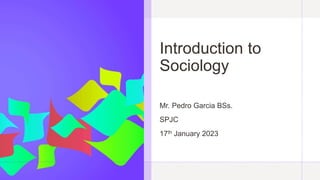
chapter 1 intro to sociology SP.pptx
- 1. Introduction to Sociology Mr. Pedro Garcia BSs. SPJC 17th January 2023
- 3. What is sociology? Sociology is the systematic study of human society. At the heart of sociology is a distinctive point of view called the sociological perspective. Society refers to people who live in a defined territory and share a way of life.
- 4. Auguste Comte(1838) Socious : companion or association Logos: word
- 6. Seeing the General in the Particular Sociological perspective is defined as: seeing the general in the particular (Berger, 1963). This tells us that sociologist look for general patterns in the behavior of particular people. It is true that every individual is unique, but society shapes the lives of people in various categories very differently.
- 7. What is a sociological perspective? “The perspective of sociology involves seeing through the outside appearances of people’s actions and organizations” (Berger, 1963). The sociological perspective is one that observes society through a lens without personal opinions. It generalizes the causes and actions of individuals into patterns and categories. However, it not only observes these patterns of society but also tries to explain such patterns or behaviors. Sociologists are not concerned with personal characteristics; instead, they aim to find common attitudes and features as well as hidden patterns in those characteristics and behaviors across millions of people.
- 8. One of the main objectives of the sociological perspective is to find and understand patterns behind recurring features of social interaction, as well as to examine the social impacts of these. With this objective in mind, there have developed many sociological perspectives but there are three major perspectives that have gained popularity. These are- structural functionalism, symbolic interactionism, and conflict theory.
- 10. What is Sociological Imagination? You will begin to see the world sociologically when you start realizing how the general categories into which we fall shape our particular life experiences. To put it simply, sociological imagination is an ability to connect personal challenges to larger social issues. However, a simple definition is not enough to explain a modestly complex idea like sociological imagination. What kind of personal challenges or social issues? How do they connect?
- 11. Sociological Perspective Vs. Common sense The sociological perspective reveals the power of society to shape individual lives. What we commonly think of as personal choice-whether or not to go to college, how many children we will have, even the decision to end our own life-is affected by social forces. Peter Berger described the sociological perspective as "seeing the general in the particular: C. Wright Mills called this point of view the "sociological imagination;' claiming it transforms personal troubles into public issues. The experience of being an outsider or of living through a social crisis can encourage people to use the sociological perspective.
- 12. The difference between sociology and common sense is based on the aim, purpose, and characteristics. Sociology is more about understanding society through a logical approach. Common sense stems from personal experiences and can only be relevant to a particular section. Common sense states only the existing conditions in society. In some cases, sociology and common sense can work together. For instance, common sense can indicate an existing problem. And the sociological aspects can help us know what changes can be made. Therefore, sociology and common sense may sound the same, but they hold varied relevance in society.
- 13. Example A good example of this is the classic study by Lillian Rubin(1976) about women’s hopes for their marriages. Rubin found that higher-income women typically expected the men they married to be sensitive to others, to talk readily, and to share feelings and experiences. Lower-income women had very different expectations and were looking for men who did not drink too much, were not violent, and held steady jobs.
- 14. Examples To sum it up: what women expect in a marriage partner has a lot to do with their social class position. The sociological perspective shows us that factors such as our sex, age, race, and social class guide our selection of a partner. It also tells us that it might me more accurate if we see ‘love’ as a feeling we have for others who match up with what society teaches us to want in a life partner.
- 15. Seeing the strange in the familiar It seems at first that by using the sociological perspective you will see the strange in the familiar. The sociological perspective reveals to us the initially strange idea that society shapes what we think and do in patterned ways.
- 16. Seeing Society in Our Everyday Lives The society which we live in have a lot of influence on our everyday choices in food, clothing, music, schooling, jobs, and just about everything else. Even the most personal decisions we make turn out to be shaped by society. To see how influential society is consider the decision by women to have children that is also governed by social patterns, or Durkheim’s classical theory about suicide that shows that even here social forces are at work.
- 18. Seeing Sociologically: Marginality and Crisis Almost everyone can learn themselves to see the world through the sociological perspective, but two situations help people to see clearly how society shapes individuals' lives: • Living on the margins of society ( The greater people’s social marginality, the better they can use the sociological perspective). • Living through a social crisis. (periods of rapid change or crisis make everyone feel al little off balance that encourages us to use the sociological perspective. C. Wright Mills (1959) illustrated this idea by using the Great Depression of the 1930s.